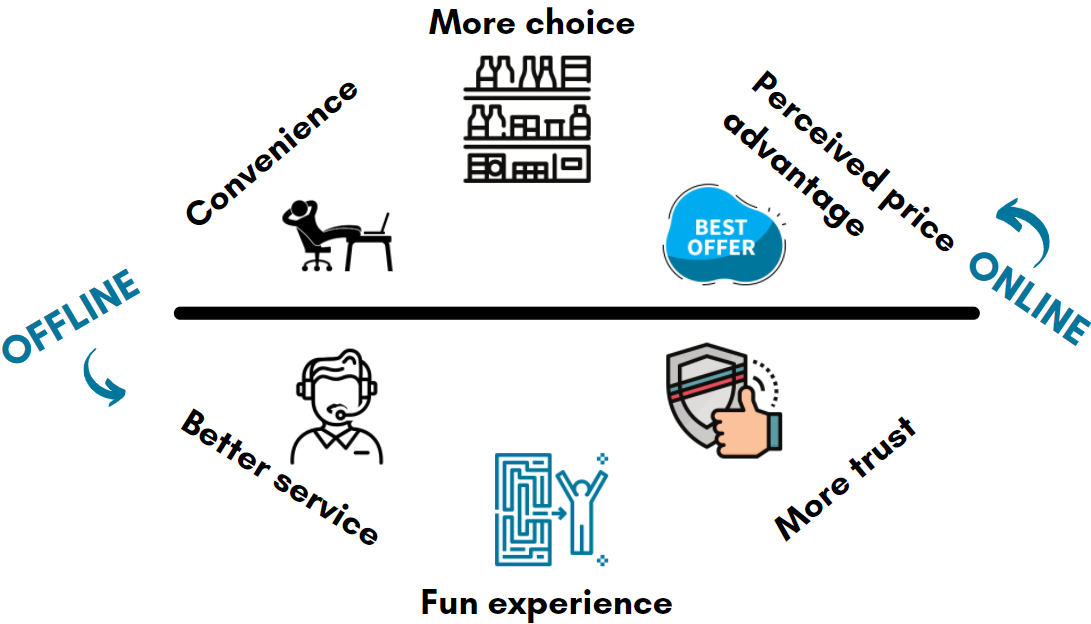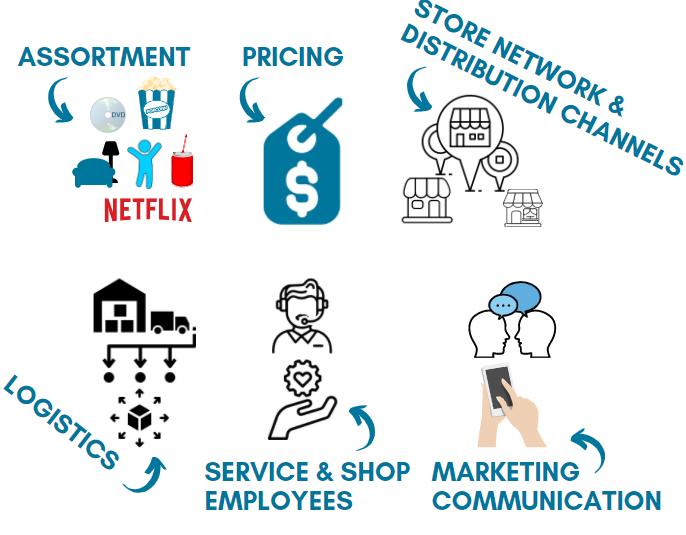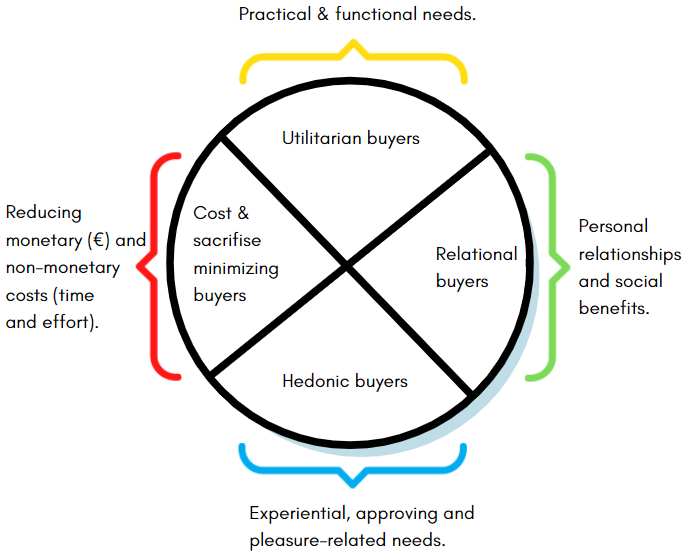Omnichannel, a buzzword many of you have heard over the past couple of years. At its core, Omnichannel is about retail innovation. More specifically, about rethinking your value proposition and its delivery aspects in a way it puts customers at the very center of your decision-making process. This way, it is complementary to Blue Ocean Strategy, and equally important within the current market.
Omnichannel places the customer central in the decision-making process in a way it gives new meaning to the word customer-centric […] Whoever doesn’t make a fundamental shift towards Omnichannel will lose against the winners of tomorrow.
Gino Van Ossel, Vlerick Business School professor
Why do we shop online or offline?
Fundamentally, Omnichannel is about integrating the advantages of online and offline into a coherent business approach, which creates new synergy effects. Something we cannot neglect in our increasingly digitized world. To start, I’ll show you why customers shop online or offline in the figure below, which is based on a figure in the book from Gino Van Ossel: Omnichannel in retail, the answer to e-commerce.

It’s pretty straightforward. People shop online because it’s easy, they have a lot of choices and there is a perceived price advantage. People shop offline because they trust it more, they get a better service (usually) and they might get a fun experience while visiting a store.
Retail innovation with reconstructing your value chain
Now, reconstructing your value chain is not easy, definitely not for existing, bigger firms. Basically, it can be split up into 6 different categories/topics which deserve your attention (Van Ossel, 2018). I’ll talk about them in this post and explain what I find most interesting.

1. Assortment in Omnichannel
As expected, your assortment is one of the biggest influencing factors. It’s the easiest way to differentiate yourself from your competitors if you get it right. But the problem is that customers might find the same or a very similar offering with a simple search on Google.
That’s why curated commerce seems to be an upcoming trend. The concept is based on offering a unique online assortment, which can’t be found anywhere else. This offering appeals to a specific customer group and is based on a personalized approach.
Integrating this principle into your physical store would be my key take-away. It seems smart to design a unique offer that appeals to a specific (important) customer group.
Of course, this is much easier said than done. For example, it requires a lot of research on which factors add value and how much your customers are willing to pay for those factors. But in the end, it’s definitely worth the effort.
2. Pricing
Pricing is the next topic, and it’s another important one. It’s a difficult variable that is related to assortment, and a lot of companies got it wrong in the past. Sometimes they put the price too high, which resulted in a lower sales rate, and sometimes they put the price too low, which resulted in a potential revenue loss.
Basically, I suggest to look at 3 things: a unique assortment, willingness to pay, and price consistency.
- A unique (value-adding) assortment is a great way of defending yourself from a price war.
- Willingness to pay conversations can give you insights into how much customers are willing to pay for certain features and why. This could help you a lot in your product configuration and bundling. “Build your own” and “purchase simulations” questions are two advanced methods for these kinds of interviews.
- Price consistency is important to avoid cannibalization of your physical stores because of your e-commerce. We don’t want our customers to buy everything online because it’s cheaper, do we? Real-time pricing is an interesting M.L. application that might be worth investigating here.
3. Store network and distribution channels
When it comes to store network and distribution channels, there are 2 things I want to talk about.
Firstly, showrooming becomes very important. Customers want to experience your product. They want to see it, taste it, feel it, smell it… You could say that sensory marketing is a big thing now. On top of that, it’s the perfect way of providing a fun experience. Doing some research on the shop atmosphere couldn’t hurt either.
Secondly, customers want to choose for themselves which channels they use. This implies an equally entertaining, easy, trustworthy,… customer experience across all channels. Look for consistency and factors that add real value to your customers. And remember, an out-of-stock item is a big pain point for people that visit your store. If it’s not available, make sure your customers know it.
4. Service and shop employees in Omnichannel
Even though service and (qualified) employees have always been important, we can expect them to become even more so in an Omnichannel World. Do you remember that people like to shop offline because it’s a fun experience, they get a better service, and because they trust it more? There you have it.
4.1 Types of services & employees
I’ll start by telling you about two different types of services: hard service and soft service. Hard service is pretty much what you expect it to be: the actual service. It could be repairing a bike, refilling shelves, delivering a package, or hard selling a product. Then, you also have a soft service, which is about HOW you provide the service. It’s about being friendly, having empathy, and acting as a host.
Personally, I expect technology advancements (ex. hyper-automation) to reduce the time employees put into operational tasks tremendously, which would increasingly shift the orientation to soft service in the upcoming years.
The next important aspect of soft service would be the changing role from traditional salesperson to advisor. This is because customers orientate (search for online information) a lot more than they used to.
Customers know a lot more about the products they’re going to buy at an earlier stage of the customer journey. It’s one of the reasons customers expect employees to act as an advisor, instead of a regular salesperson that’s trying to get a big score.
Last but not least, the autonomy-support context becomes more important in our so-called ‘self-service economy’. Apparently, customers have an increased desire to do things themselves without interference from shop employees. In the online world, chat-bots could be interesting to look at.
4.2 Types of buyers
If you start focusing on soft service and your role as an advisor within an autonomy-support context, it might be clever to learn more about the types of buyers out there. Don’t you think it would be beneficial to know who you’re talking to, so you can be the type of employee they expect you to be?
Barwitz & Maas (2018) performed scientific research on this. They concluded (using a means-end chain) that customers can be grouped into 4 categories.
- Utilitarian buyers
- Hedonic buyers
- Cost or sacrifice minimizing buyers
- Relational buyers
Utilitarian buyers are concerned with the practical, functional, and instrumental benefits that a particular channel offers to meet their needs. This in contrast to hedonic buyers, who look for experiential, approving, and pleasure-related values.
Customers looking to minimize costs and sacrifices want to reduce both monetary costs (€) and non-monetary costs (time and effort). Relational buyers, in turn, are looking for personal relationships and social benefits.

Perhaps it’s smart to come up with an easy way to identify these different types of buyers and teach employees how to approach them. However, it’s important to note that these types can overlap.
For example, because of the increased price sensitivity and transparency (R.P. Rooderkerk et al., 2019), I expect most customers to fit the cost & sacrifice minimizing profile. I also remember something about fun experiences (hedonic values) and convenience (utilitarian values) becoming more important…
5. Logistics
Let’s talk logistics, which is supposed to be the edge of your sword in Omnichannel. As you can imagine, it’s a challenging topic with a variety of variables to consider. I’ll try to steer clear of numbers and talk about some more general trends.
Firstly, new logistic models are being developed. In the past, stores usually got their supplies from a centralized distribution center (D.C.). Centralized D.C.’s are still an option today, but there are a lot more options to consider. For example, de-centralized distribution centers (D.C.) and dark stores.
De-centralized distribution centers were born to bridge the gap between centralized D.C.’s and customers more efficiently. You can imagine it’s a lot faster, economical, and ecological to bring goods from the edge of the city, then having it delivered by a truck that has to travel a (much) bigger distance.
Dark stores are comparable with these de-centralized D.C.’s. However, they’re usually smaller and could serve as a pick-up point. They might look (or even serve) as an actual store, but they’re still just D.C.’s located closer to the customer.
Another interesting trend is outsourcing logistics to external parties, which is called 3rd party logistics. Katoen Natie is an interesting player that gained a lot of visibility recently.
To end this section about logistics, I would like to talk about Artificial Intelligence (A.I.) and Machine Learning (M.L.). Due to their analytical nature, logistics provide the perfect habitat for A.I. and M.L. solutions to develop, prosper, and provide real value to retailers and customers. I would suggest reading up on your options!
6. Marketing communication
There are two interesting trends I want to talk about: the connected (personalized) shop and webshop, and location-based communication.
The connected (personalized) shop and webshop provide customers with the same functionalities (benefits) in the offline and online store. One of these functionalities would be the ease of finding (and switching between) product categories (R.P. Rooderkerk et al., 2019).
For example, customers (usually) have a search bar and clearly grouped product categories online. In the offline world, customers might have trouble finding the things they want. Remember how difficult it was to find that specific piece of clothing you saw online without the help of employees? There you have it.
Location-based communication is a related concept. It’s about (personalized) communication with your customers at the point-of-purchase (POP). Here, it’s important to know where (and who) your customers are. It could be interesting to look at geofencing, a concept where you set up a virtual perimeter in which customers receive a tailor-made message or offer.
Here we are – we covered the six topics that I think you should consider while reconstructing your value chain in Omnichannel. Of course, there’s probably a lot more that we haven’t discussed yet. It’s important to spend enough time researching and investigating what your customers really want and need.
I know some of these things might sound abstract, which is why I suggest reading this book about Omnichannel and this book about willingness to pay. But, I hope that this article can serve as an interesting starting point on your journey to retail innovation. In the end, Omnichannel is about putting your customers central in the decision-making process. Good luck!
Newsletter
Subscribe our newsletter to get our latest update & news

